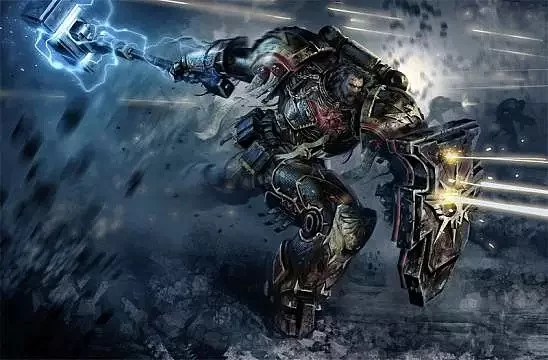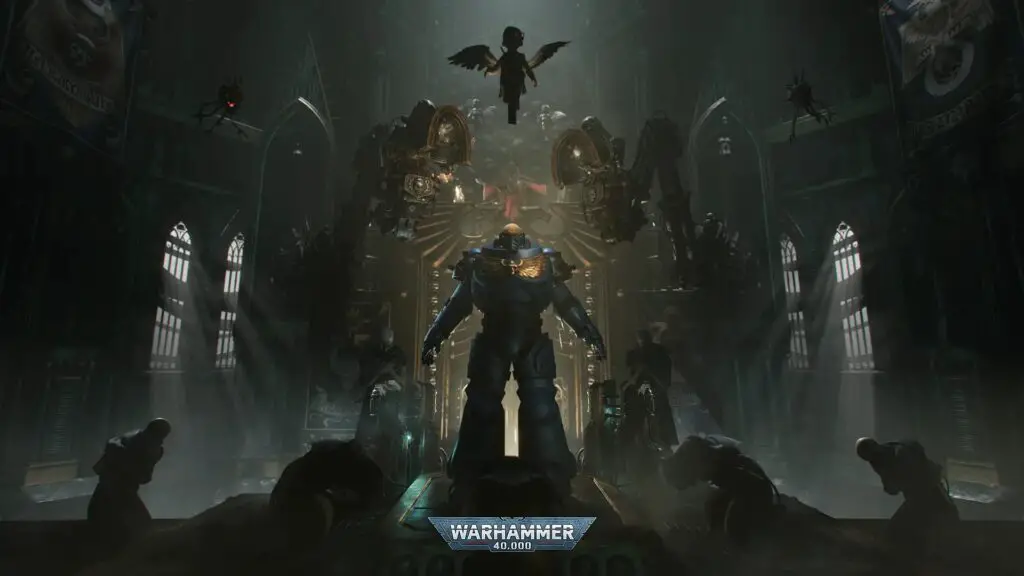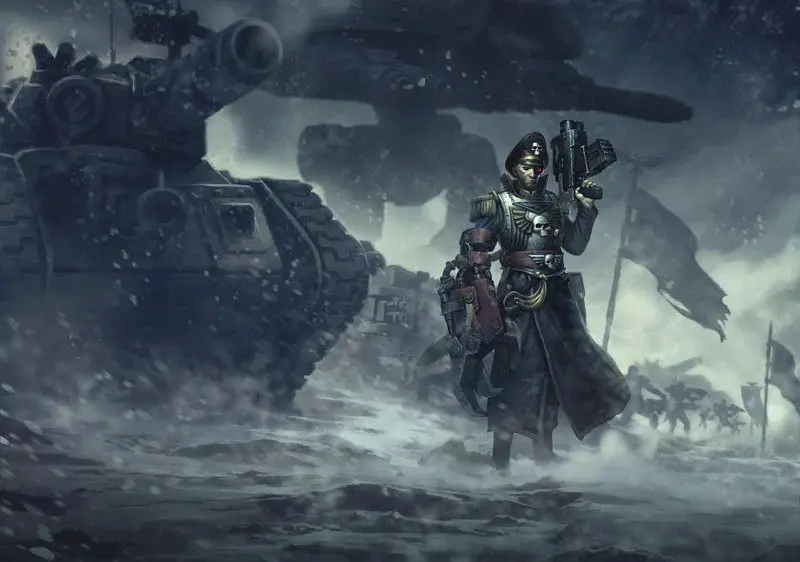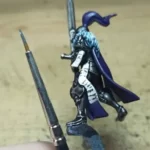Exploring the Dark Themes of the Warhammer 40,000 Universe

As the franchise that stands as the poster child of the term grimdark, Warhammer has some rather dark themes present.
Even the tagline of the game “In the grim darkness of the 41st millennium, there is only war” oozes a hopeless, dark routine that the setting has.
Warhammer 40k is often recognized for its grim nature. The darkness of the 40k setting isn’t without its merits. The grim future of 40k is supported by rich lore and history. One where humanity suffers greatly for every step forward it takes, facing a constant assault from various enemies.
Why is 40k so dark?
This dark setting of the Warhammer 40,000 universe is a result of the decline of the once glorious Imperium of Man, where various factions are vying for power and control in a never-ending cycle of violence. The imperium’s oppressive rule and constant wars have also led to widespread suffering and loss of life among the population, making it a bleak and hopeless existence.
This bleak and dystopian atmosphere is at the core of the “Warhammer 40,000” experience, which appeals to fans who enjoy exploring dark and mature themes in their entertainment.
A quick explanation of the 40k lore, and the darkness
Long story short, humanity has spread out far across the stars millennia ago. After the expansion, the colonies of humanity got cut off for thousands of years.
Eventually, they are reunited by the Emperor, a psychic leader of humanity. This new conglomeration of planets was the start of the union which will eventually be known as the Imperium of Man.
However, a civil war breaks out. It ends with the Emperor being mortally wounded, while the Imperium of Man goes into an exceptionally oppressive political state.
Fascistic laws and paranoid policing of the populace became the norm in the Imperium of Man. The justification for them being found in past ages of the world.
After that era, many events lead to the tightening of oppressive laws and the bolstering of religious fervor.
Is the Warhammer 40k lore bad?
While it can be inconsistent in quality the general lore of Warhammer 40k is not bad and is really intricate. Since the first bit of lore in 1987, there have been some quality pieces of writing in the franchise.
Every extremely dark aspect of the franchise is supported by in-universe explanations. This makes the grim world feel legitimate rather than something played for shock value.


The Dark Setting of Warhammer 40,000
The universe of Warhammer 40k is one that is characterized by its grimdark tone. Constant strife, conflict, and death loom over every human in the setting. None are safe from forces that be.
The entirety of mankind is at constant risk from threats outside and inside of it. The inner dangers make life harder for the common folk while fueling galaxy-wide paranoia. The universe is a feedback loop of atrocities fueled by aliens, Chaos, and mankind itself.
The dystopian world of Warhammer 40,000 and its depiction of a bleak future
The future found within the pages of Warhammer 40k books showcases not only fantastical weaponry and races but a fresh take on space-age humanity.
The Imperium is an oppressive place. Human life is cheap, no matter where in the galaxy you find yourself. Millions die just running the factories that keep the war engine going.
Most citizens are given basic necessities for survival and expected to contribute to the general purpose of their worlds. Planets are plentiful and strictly organized into classes that benefit the Imperium.
Each world is classified by its functionality. Classifications determine what the world is used for, affecting the overall quality of living on it and the expected output of a planet. Failing to contribute may doom the entire planet.
All of these struggles in 40k are compounded by the constant threat of various aliens. Their motives vary but are all devastating to the human population. The goals of these aliens being antithetical to humanity is what makes them a massive danger.
There is also Chaos, a metaphysical force whose forces and allies seek to corrupt humanity. Even a regular citizen can fall prey to it and eventually become its servant.
The elements that contribute to the dark atmosphere, such as war, death, and oppression
Death and war are a constant state of being within the galaxy. Both present in a far more brutal manner with all the setting-specific weaponry at disposal.
Guns that flay targets alive, plagues that make one beg for death, and planet-destroying explosive payloads are just some harrowing examples from the setting. Each brings a new flavor of horrifying death and darkness during times of war.
Those who avoid death and war don’t have it much better. Living in the Imperium of Man means adhering strictly to all of its draconian laws. Even minor violations of the law could result in heavy punishment.
The Lore Behind the Darkness
What makes the story behind the world of Warhammer 40k good is how intricate it is. Spanning back thousands of years, the history of the universe is an endless hole to explore.
The darkness of the 40k universe is supported by hundreds of books, games, or other pieces of knowledge on the lore. Making it feel narratively justified rather than purely shocking.
The history and background of the Warhammer 40,000 universe
With thousands of years to its history, Warhammer 40k boasts many important events. However, the simpler way to comprehend its history is by going over the major ages of the world.
- The Dark Age of Technology is the era during which mankind was at its scientific peak. The most advanced technology currently available in the setting are remnants from this era.
- Age of Strife, also known as “Old Night” is an apocalyptic event that lasted for five millennia. This age is characterized by extreme chaos and conflict.
The combination of this era and Horus Heresy was the main motivator for many hateful and oppressive policies developed in the latter Imperium of Man.
Destruction introduced by weapons from the Dark Age of Technology also introduced technophobia into the culture of the Imperium.
- Age of Apostasy was another massive destabilizing era of the Imperium. It spawned from confrontations between Ecclesiarchy, the official state church of the Imperium, and Administratum, the administrative and bureaucratic body of the Imperium.
It led to 100 years of bloody maniacal rule by a man called Goge Vandire. This era continued sometime past his death before finally ending.
- Next was the Age of Redemption, where worship of the Emperor grew, and was getting quite zealous.
This era included many crusades, purging of heresy, and overall heavy religious endeavors which exhausted the Imperium. This weakened the Imperium to outside threats, especially those of Orks and Tyranids.


The events that led to the creation of the dark and oppressive world
While previous ages were general coverage of the events in the universe, here are two galaxy-shaking events that led to the dark state of Warhammer 40k’s world.
- Fall of Aeldari is an event tied to an extremely advanced alien species who turned to hedonism out of superiority-induced boredom. This behavior eventually manifested in the spiritual world as the God of pleasure and excess, Slaanesh.
The birth of this God led to galaxy-wide disarray, eventually shunting mankind into the Age of Strife. This event also opened a wound in reality called Eye of Terror which encompasses thousands of worlds and makes interstellar travel difficult.
- Horus Heresy was the second event that added to the darkness of the 40k universe. It destabilized the Imperium and made a rift within its strongest army force, Space Marines.
However, the Emperor of Mankind being injured into a comatose state was the greatest blow to humanity. His absence allowed many oppressive and mismanaged laws to pass.
The different factions in the Warhammer 40,000 universe and how they contribute to the dark atmosphere
Factions are key to the world of Warhammer 40k and make it so infinitely dark. While not all are heavily disturbing in their behavior, a few warrants mentions.
- Inquisition is the galaxy-wide police of the Imperium. They hunt down and torture anybody suspected of heresy.
Inquisition has sickening methods of keeping peace as the “secret” police of the Imperium. Your innocence doesn’t matter, only their opinion.
- Drukhari, space pirate aliens, are another horrible faction. Not only do they take slaves but inflict awful suffering upon them.
Any sadistic behavior you can imagine has already been performed by Drukhari, probably to a degree most humans can’t fathom.
- For a less bombastic faction that impacts the tone of the world look no further than Adeptus Administratum.
This bureaucratic center of the Warhammer 40k universe is prone to mistakes. Misplacing emergency calls, mismanaging resources, or even losing entire planets from the ledger.
The Significance of the Darkness
The darkness of the setting also works as an old cosmological duality of Order and Chaos. Neither of which is inherently good. The Imperium of Man represents Order, with its rules and organizations being overbearing examples of law.
Chaos is represented by the same name in the setting. In the setting, its goal is to return everything to the primordial soup that once was. There are scarce rules to Chaos or its worshippers. Not even laws of science apply to their bodies, as most worshippers eventually turn mutants.
This duality without the compromise of good or evil gives more intrigue to the moral implications. While those are rarely the centerpiece of fiction within the setting, it’s fun to discuss within the fandom.
Of course, there are also alien races. These give diversity to the aforementioned clash of Order and Chaos with their unique cultures. Their introduction often makes for more mundane horrors within the setting.
All of these aspects combined bring over the struggle and hopelessness. Maintaining the mantra that the future holds nothing but war. It is a bleak vision that only benefits from the dark material found in the lore of the world. One that would be contradictory if the conditions of the world weren’t as grim.
Why the dark setting of Warhammer 40,000 has become a defining characteristic of the game world
The intertwined darkness of the setting found itself as an important part of the game’s identity right from the get-go. All over-the-top weapons and instruments of war were put into perspective by the equally extreme living conditions.
While one would expect such advanced technology to improve life, darker parts of the setting provide information on why science has grown stagnant. As we’ve seen, there are multiple causes for the setting’s fear of progress.
Aesthetically, the various darker aspects of the lore contribute to the look of Warhammer 40k. Numerous skulls that adorn each faction’s armor, harrowing mutations, and bloody battlefields have all become striking visuals that effectively describe the setting.
How the darkness adds to the richness and depth of the Warhammer 40k lore
Lack of technology, intense loss of human life, and oppressive regimes, all support the dystopian setting. The explanations of these aspects directly contribute to the world feeling well thought out and fleshed out.
We’ve already covered different ages that have preceded the current state of the Imperium. Those provide ample insight into the sheer depth of each twisted law currently present in the setting.
How the dark setting of Warhammer 40,000 compares to other popular science fiction or fantasy universes
When compared to other science fiction that came before, Warhammer 40k feels excessively brutal. Often giving barely any respite to the struggles of its characters. Each success is paid considerably and rarely is it a long-lived victory.
If you compare it to another science fiction story like Star Wars you start to see many differences.
While both universes have galactic wars being waged for years on end, Star Wars keeps a decent amount of regularity in the lives of ordinary folk. They aren’t being shoved into world-spanning factories to work until death nor are they constantly in fear of daemon incursions from literally thin air.
Star Wars heroes are also far more admirable and human. These traits are difficult to find in mostly superhuman warriors of the Imperium, who outlive entire planets.
The differences are clear. Moral ambiguity is what keeps Warhammer 40k feeling fresh while the grit of its setting acts as a support beam of that questionable morality.
Conclusion
Warhammer 40k’s dark tone comes from a combination of aesthetical and narrative reasons. With both being equally important to the identity of the game.
The dangers Imperium of Man experiences and extreme solutions it employs ask many questions about its morality. Adding up to an intricate, morally ambiguous world.
Sources:
https://en.wikipedia.org/wiki/Grimdark
https://warhammer40k.fandom.com/wiki/Adeptus_Administratum
https://warhammer40k.fandom.com/wiki/Age_of_Strife
https://www.belloflostsouls.net/2017/09/40k-aesthetics-ad-mech.html



